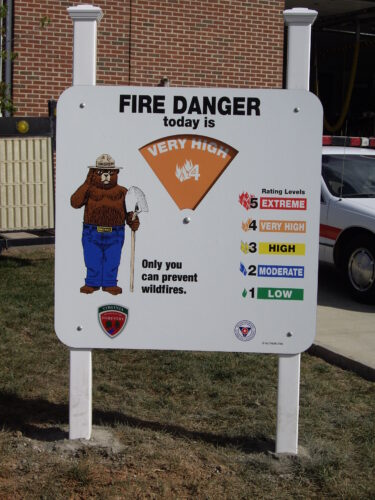Daily Fire Danger Rating
| December 15, 2025 9:08 am |
Class Day Today | Predicted Class Day Tomorrow |
KBDI* | Precipitation | Wind Speed | Wind Direction |
|---|---|---|---|---|---|---|
| Wakefield | 2 | 2 | 179 | .02 | 5 | W |
| Tappahannock | 1 | 2 | 317 | .04 | 5 | W |
| Charlottesville | 2 | 2 | 287 | .04 | 7 | S |
| Farmville | 2 | 2 | 227 | .07 | 5 | SW |
| Salem | 1 | 1 | 386 | 0 | 10 | W |
| Abingdon | 1 | 1 | 228 | 0.21 | 8 | SW |
Comments:
*KBDI - Keetch-Byram Drought - Index with a range from 0 (complete ground saturation) to 800 (desert-like conditions). No Report – That area did not submit a report.
Wildfire Summation Report
Daily Wildfire Summation Report
| December 15, 2025 9:08 am |
No. of Fires | No. of Acres | Year-to-Date Fires | Year-to-Date Acres | Homes Damaged | Homes Protected | Structures Damaged | Structures Protected |
|---|---|---|---|---|---|---|---|---|
| Wakefield | 0 | 0 | 53 | 783 | 0 | 0 | 0 | 0 |
| Tappahannock | 0 | 0 | 80 | 343 | 0 | 0 | 0 | 0 |
| Charlottesville | 0 | 0 | 192 | 1,063 | 0 | 0 | 0 | 0 |
| Farmville | 0 | 0 | 141 | 504 | 0 | 0 | 0 | 0 |
| Salem | 0 | 0 | 73 | 1,802 | 0 | 0 | 0 | 0 |
| Abingdon | 0 | 0 | 200 | 5,573 | 0 | 0 | 0 | 0 |
| Daily Total | 0 | 0 | 0 | 0 | 0 | 0 |
Cumulative Annual Wildfire Summation Report
| Fires Reported Since | Fires | Acres | Homes Damaged | Homes Protected | Structures Damaged | Structures Protected |
|---|---|---|---|---|---|---|
| January 1 | 762 | 12,761 | 3 | 134 | 20 | 133 |
| October 15 | 161 | 3,533 | 0 | 41 | 2 | 42 |

The Virginia Department of Forestry (DOF) monitors weather and fuel conditions on a daily basis to estimate the expected level of wildfire activity in the Commonwealth. Since DOF responders do much more than responding to reports of wildfire, this daily fire danger measurement guides the agency’s overall readiness expectation for its suppression personnel.
Using components of the National Fire Danger Rating System (NFDRS), DOF fire managers are able to predict the fire weather for today and tomorrow, establishing a readiness class day measure of 1 to 5. Known as the agency “readiness level”, this reading establishes specific response expectations for agency personnel and equipment, ensuring that DOF remains prepared for fire suppression throughout the Commonwealth.
The DOF produces a Daily Wildfire Summation Report that provides information on the previous day’s wildfires and impacts, another indicator of the overall wildfire danger and risk level within the Commonwealth.
This daily fire danger rating is also one factor to consider for anyone who may be thinking about burning debris. Always follow safe burning practices.
Readiness Class Day Definitions
The specific readiness class day measures used by the DOF are defined below:
Class 1 – LOW Fire Danger
- No appreciable fire activity.
- Fires do not ignite readily.
- Fires that do start spread slowly and often burn irregularly.
Class 2 – MODERATE Fire Danger
- Occasional fire activity.
- Fires can start from most accidental causes; number of starts generally low.
- Fires burn at low to moderate rates; heavy fuel concentrations may burn hot.
- Fires usually controlled in initial attack phase.
Class 3 – HIGH Fire Danger
- Normal fire season activity.
- Fires start easily from most causes.
- Fires burn at moderate to fast rates; control can be difficult if control action is not started promptly.
Class 4 – VERY HIGH Fire Danger
- Above normal fire activity and/or conditions.
- Fires start readily and spread rapidly.
- Control of head fires may be difficult to impossible until fire behavior factors change.
Class 5 – EXTREME Fire Danger
- Severe fire conditions.
- Fires often escape initial attack. Direct attack of fires virtually impossible.
- Fire behavior is erratic; resistance to control is high. Fires are not usually controlled until burning conditions subside.
- Potential for fire disaster is high.
- Multiple fire starts are likely.
Always check with local officials about local burn restrictions.
